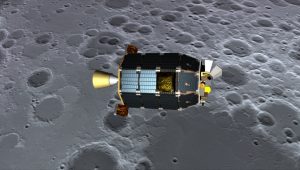 Ground controllers at NASA’s Ames Research Center have confirmed that NASA’s Lunar Atmosphere and Dust Environment Explorer (LADEE) spacecraft impacted the surface of the moon on April 17, 2014. LADEE lacked fuel to maintain a long-term lunar orbit or continue science operations and was intentionally sent into the lunar surface.
Ground controllers at NASA’s Ames Research Center have confirmed that NASA’s Lunar Atmosphere and Dust Environment Explorer (LADEE) spacecraft impacted the surface of the moon on April 17, 2014. LADEE lacked fuel to maintain a long-term lunar orbit or continue science operations and was intentionally sent into the lunar surface.
The spacecraft’s orbit naturally decayed following the mission’s final low-altitude science phase.
During impact, engineers believe the LADEE spacecraft, the size of a vending machine, broke apart, with most of the spacecraft’s material heating up several hundred degrees – or even vaporising – at the surface. Any material that remained is likely buried in shallow craters.
“At the time of impact, LADEE was travelling at a speed of 3,600 miles per hour – about three times the speed of a high-powered rifle bullet,” says Rick Elphic, LADEE Project Scientist at Ames. “There’s nothing gentle about impact at these speeds – it’s just a question of whether LADEE made a localised craterlet on a hillside or scattered debris across a flat area. It will be interesting to see what kind of feature LADEE has created.”
In early April, the spacecraft was commanded to carry out manoeuvres that would lower its closest approach to the lunar surface. The new orbit brought LADEE to altitudes below one mile above the lunar surface. This is lower than most commercial airliners fly above Earth, enabling scientists to gather unprecedented science measurements.
On April 11, LADEE performed a final manoeuvre to ensure a trajectory that caused the spacecraft to impact the far side of the moon, which is not in view of Earth or near any previous lunar mission landings.
In the coming months, mission controllers will determine the exact time and location of LADEE’s impact and work with the agency’s Lunar Reconnaissance Orbiter (LRO) team to possibly capture an image of the impact site. Launched in June 2009, LRO provides data and detailed images of the lunar surface.
Launched in September 2013 from NASA’s Wallops Flight Facility in Virginia, LADEE began orbiting the moon on October 6 and gathering science data on November 10. The spacecraft entered its science orbit around the moon’s equator on November 20, and in March 2014, LADEE extended its mission operations following a 100-day primary science phase.








Add Comment